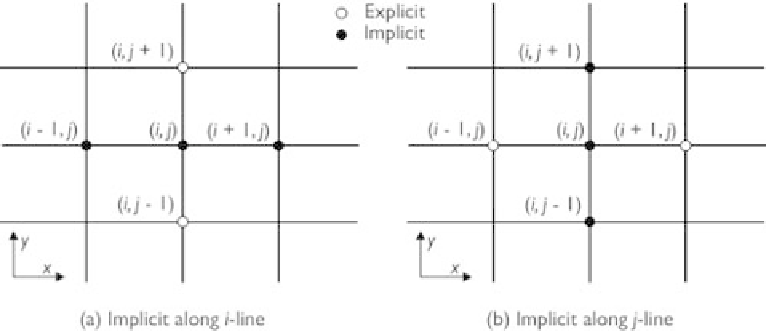Geoscience Reference
In-Depth Information
often used:
φ
(
1
/
2
)
i
φ
(
1
/
2
)
i
,
j
φ
(
1
/
2
)
i
φ
(
0
)
i
,
j
φ
(
0
)
i
,
j
−
a
W
+
a
P
−
a
E
=
a
S
+
a
N
+
b
(4.222)
−
1,
j
+
1,
j
−
1
+
1
φ
(
1
)
i
,
j
φ
(
1
)
i
,
j
φ
(
1
)
i
,
j
φ
(
1
/
2
)
i
φ
(
1
/
2
)
i
−
a
S
+
a
P
−
a
N
=
a
W
+
a
E
+
b
(4.223)
−
+
−
+
1
1
1,
j
1,
j
Eqs. (4.222) and (4.223) are implicit in single directions and can be directly solved
using the Thomas algorithm described above. Because the boundary-condition infor-
mation from the two ends of the grid line is transmitted at once to the interior of the
domain, the ADI method converges faster than the Jacobi and Gauss-Seidel iteration
methods.
Figure 4.27
Calculation sequence in ADI method.
Efficiency of the ADI method can be improved by using the value at the new time
level for one of the variables on the right-hand sides of Eqs. (4.222) and (4.223). For
example, in Eq. (4.222)
φ
(
0
)
i
,
j
φ
(
1
/
2
)
i
,
j
1
can be replaced by its latest value
1
, which has been
−
−
−
calculated in the solution of Eq. (4.222) along the
j
1 line, if the sweep is done by
the order of increasing
j
. The same approach can be applied to Eq. (4.223) along the
i
line, in which
φ
(
1
/
2
)
i
φ
(
1
)
i
1,
j
can be replaced by
1,
j
if the sweep is carried out in the order
−
−
of increasing
i
.
4.5.4 SIP iteration method
Consider a 2-D problem discretized by a five-point numerical scheme, the algebraic
equations of which are Eq. (4.219). One may write the set of algebraic equations in
matrix form:
A
=
b
(4.224)
where
A
is the coefficient matrix,
is the vector of the unknowns, and
b
is the vector
of the source terms. If
is numbered in the order of increasing
j
and then increasing
i
,

